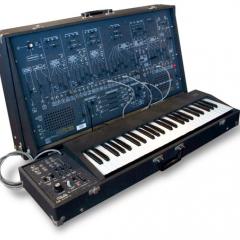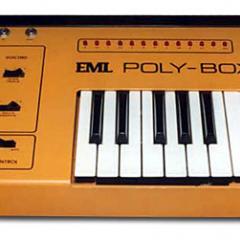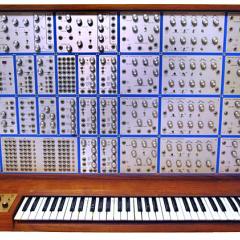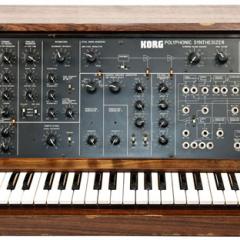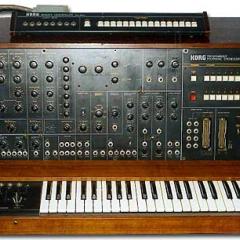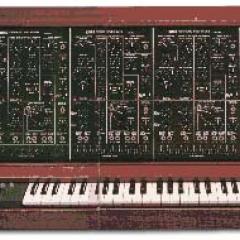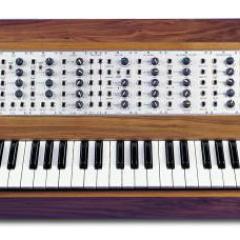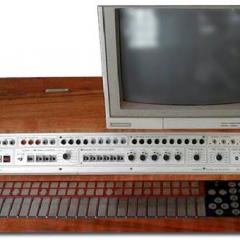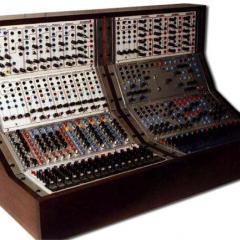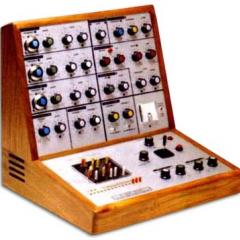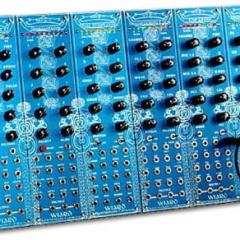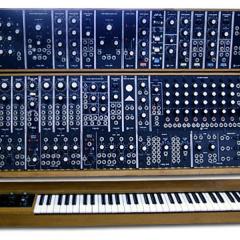ARP 2500

In 1969 ARP Instruments was formed by Alan R. Pearlman, an electronics engineer inspired by what the Moog synthesizer was doing, particularly after hearing the now famous Wendy Carlos album, “Switched on Bach”. In 1970, ARP introduced its first modular synthesizer, the model 2500. As with almost everything ARP did during its existence, the 2500 was designed in direct competition with the Moog synthesizers that were garnering most of the attention at the time.
The 2500 is a technologically advanced synthesizer following the traditional modular format. There are 15 modules covering all the bases: VCOs, filters, envelope generators, modulators, sample and hold circuits, even a sequencer. The Studio wood cabinet had space for 15 modules, and smaller 8-space Wing cabinets allowed for expanded or portable systems. Like all modular systems of the day, buyers got to custom order their system with any combination of modules, cabinets and keyboard options. This means that existing 2500 systems today could come in any number of possible configurations, from compact portable systems to over-blown multi-cabinet multi-keyboard behemoths.

Unlike other modular synthesizers, the 2500 does not use patch cables to route the signal between its modules. It uses a unique 10x10 matrix switch system to accomplish signal routings. Modules are located in the center row of the cabinet, with the matrix switches located above and below the modules. Module inputs and outputs are represented by vertical switches, and the horizontal busses represent a patch cord. Color-coded pins are positioned horizontally along the matrix to make connections. This matrix system allows for a very flexible and customized signal flow without the mess of patch cables. The only downsides are the potential for crosstalk between the busses, and it may seem less obvious at a glance just exactly what is being patched into what than with traditional patch systems.
The 2500's modules themselves are also a bit overwhelming. The 2500 allows you to create plenty of excellent sounds with its great filters and many other excellent circuits and parameters. However, it is clear that these modules were designed by an engineer and not a musician. The modules are covered in electronic diagrams and offer a ton of controls. The high learning curve the 2500 presents made it a popular addition to the music departments of universities. But it was the easier to navigate ARP 2600 that would provide a much more musician-friendly experience and would prove to become ARP's most popular synthesizer.
Nevertheless, a 2500 is a prized piece of kit for any studio. The 2500s are known to have superior oscillators to the Moog, offering reliable and stable tuning that does not drift. These may not be for the faint of heart, but the results of creating your own sounds on them will be very rewarding. Since only about 100 were sold (give or take), they are also very rare. It has been used by Meat Beat Manifesto, Pete Townshend, Jean-Michel Jarre, Vangelis, Jimmy Edgar, Vince Clarke, Roger Powell (Cosmic Furnace), David Hentschel (w/ Elton John & Peter Hammil), Joe Renzetti and Tony Luisi (Electric Tommy), Hugo Montenegro, Patrick Gleeson (w/ Jon Mark), Joop Stokkerman, Faust, Eliane Radigue, filmcomposer Jerry Goldsmith on 'Logan's Run', and communicating with the aliens in Spielberg's Close Encounters of the Third Kind.

Function Modules:
- 1001 Blank Panel.
- 1002: Power Supply.
- 1003: Dual Exponential Envelope Generator. High speed, flexible.
- 1004p: Voltage Controlled Oscillator. Basic ARP precision VCO offering five simultaneous waveform outputs: sine, triangle, square, sawtooth, and pulse. FM and PWM. Built-in waveform mixer.
- 1004t: Voltage Controlled Oscillator. Same as 1004p except inverted waveform outputs available.
- 1005: Modamp. A complex function module containing a precision balanced modulator, a voltage controlled amplifier, and switching circuitry.
- 1006: Filtamp. A compact module containing a mixer, a voltage controlled lowpass filter, and a voltage controlled amplifier.
- 1016: Dual Noise/Random Voltage Source. Contains two independent uncorrelated noise sources and filters to derive pink noise and continuous slow random voltages.
- 1023: Dual Voltage Controlled Oscillator. Two precision voltage controlled oscillators each similar electrically to the 1004.
- 1027: Ten-Position Sequencer: Unusually flexible and reliable sequential voltage generator. Capable of creating highly complex switching patterns with 30 preset voltages.
- 1033: Dual Delayed Exponential Envelope Generator. Same as 1003 but includes variable trigger delay.
- 1036: Dual Sample & Hold/Random Voltage Generator. Contains two ultra-low-drift sample and hold circuits, two noise sources, and two voltage controlled pulse generators.
- 1045: Voltage Controlled Voice. Combination two Envelope Generators/Voltage Controlled Oscillator/Voltage Controlled Filter/Voltage Controlled Amplifier. Use as preset voice.
- 1046: Quad Exponential Envelope Generator: Ultra-compact module containing a pair of envelope generators without trigger delay and a pair with delay.
- 1047: Multimode Filter/Resonator. Combination highpass, lowpass. bandpass, and band-reject filter. Ultra-high Q. Voltage controlled center frequency and resonance.
- 1050: Mix/Sequencer. A combination sequencer, mixer, analog gate. Serves dozens of functions as a utility mixer, sequencer, preset function selector.
Keyboards:
- 3604: Portable One Voice Keyboard. 4 Octaves.
- 3001: One Voice Keyboard. 5 Octaves.
- 3002: Two Voice Keyboard. 5 Octaves.
- 3212: Three Voice Split Keyboard. 5 Octaves.
- 3222: Four Voice Split Keyboard. 5 Octaves.
- (All keyboards include variable tuning, variable tone interval, and variable portamento controls.)
Cabinets:
- 2508: Studio Wing Cabinet. 8 Module Positions.
- 2515: Studio Cabinet. 15 Module Positions. 47 inches wide, 22 inches tall.
- 2508P: Portable Wing Cabinet. 8 Module Positions.
Original list prices for modules ranged from $400 to $1,200 with complete systems going for $8,000 to $20,000. Adjusted for inflation, that would be something like $45,000 to $110,000 today!!!
Demos & Media
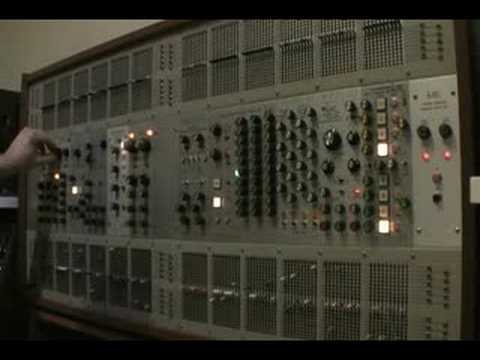
Specifications
1023: Dual Voltage Controlled Oscillator
1016: Dual Noise/Random Voltage Generator
1006: Filter-amp
1046: Quad Envelope
1033 Dual Delayed Exponential Env Generator
1050: Mix/Sequencer
Resources
Images from Matrixsynth and The Terry Collection at Old Tech - Vintage Synthesizer Site.
Thanks to Dave Peck for providing information.
Review updated June 2012.
